|
|
|
Sort Order |
|
|
|
Items / Page
|
|
|
|
|
|
|
| Srl | Item |
| 1 |
ID:
083439
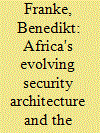

|
|
|
|
|
| Publication |
2008.
|
| Summary/Abstract |
Following decades of feeble attempts, Africa's states have recently made great strides in establishing an elaborate security architecture to tackle the continent's many perils. I argue that the emergence and particular structure of this architecture and its institutional layers are best described by the constructivist concept of multilayered security communities. While this concept is based on the original idea of security communities by Karl Deutsch and its later adaptation by Emmanuel Adler and Michael Barnett, it recognizes the increasing prominence of elaborate multi-level security cooperation in the developing world and the difficulties of the original theoretical framework to account therefor. Consequently, it combines security community terminology with notions such as organized complementarity and multi-level governance to do conceptual justice to systems like Africa's decentralized collective security arrangement.
|
|
|
|
|
|
|
|
|
|
|
|
|
|
|
|
| 2 |
ID:
102895
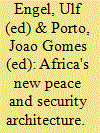

|
|
|
|
|
| Publication |
Farnham, Ashgate Publishing, 2010.
|
| Description |
xix, 179p.
|
| Series |
Global security in a changing world
|
| Standard Number |
9780754676058, hbk
|
|
|
|
|
|
|
|
|
|
|
|
Copies: C:1/I:0,R:0,Q:0
Circulation
| Accession# | Call# | Current Location | Status | Policy | Location |
| 055843 | 355.03306/ENG 055843 | Main | On Shelf | General | |
|
|
|
|
| 3 |
ID:
172381
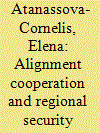

|
|
|
|
|
| Summary/Abstract |
Although the US-led system of formal alliances remains the main pillar of the regional security architecture in Asia, alignment cooperation – centred on the Indo-Pacific maritime conceptualisation of the region – has been on the rise. This includes informal bilateral and minilateral agreements for security collaboration between regional and extra-regional US treaty allies or close security partners, notably Japan, Australia, India, the United Kingdom and France. While the various alignments complement and address the deficiencies of the formal US-led alliances, the functional and informal characteristics of alignments allow countries to pursue security cooperation both in conjunction with the United States and independently of it. This leads to a more fluid security architecture that increasingly reflects the diversity of emerging regional ‘architects’, among which Japan is assuming a leading role, as much as the region’s array of new security challenges.
|
|
|
|
|
|
|
|
|
|
|
|
|
|
|
|
| 4 |
ID:
160611
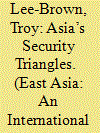

|
|
|
|
|
| Summary/Abstract |
Since the early years of the twenty-first century, a number of key regional governments have consciously chosen to alter the way they talk about the region, and have now largely shifted from using the ‘Asia-Pacific’ to the ‘Indo-Pacific’ construct. But after three decades of utilising the ‘Asia-Pacific’ concept, why has this been the case and how might this shift in geographical conceptualisation alter the strategic framework of the region? This paper argues that the ‘Indo-Pacific’ is a regional reconceptualisation utilised by Japan, Australia, India and the USA to address deficiencies in Asia’s maritime security and institutional architecture, which are being simultaneously influenced by a more assertive Chinese posture and waning U.S. influence. Additionally, the Indo-Pacific concept has developed in tandem with a transformation in the regional security architecture. The utilisation of maritime minilateralism between Japan, India, Australia and the USA supplements Asia’s bilateral American alliances, with an array of trilateral security dialogues or ‘security triangles’. The Asia-Pacific to Indo-Pacific shift is really an instance of an emerging minilateral security regionalism, rather than the predominant forms of bilateral and multilateral security and economic regionalism that have dominated Asia in recent decades.
|
|
|
|
|
|
|
|
|
|
|
|
|
|
|
|
| 5 |
ID:
117641


|
|
|
|
|
| Publication |
2012.
|
| Summary/Abstract |
China, as host of the six-party talks first convened in August 2003, has
been one of the major players in dealing with the North Korean nuclear crisis that
began in October 2002. China's role in the talks has helped to start shaping a stable
regional security architecture in Northeast Asia. Beijing's leadership in building a
new security regime in the region suggests a change on Chinese perspectives regarding its role within the broader East Asia's regional security architecture. After years of
passiveness with regards to involvement in security regime building in the region,
China has evolved into an active leader seeking to shape a more institutionalized
security. Despite the obstacles to building a functioning regime in Northeast Asia,
China seems poised to continue working towards creation of a more stable and
institutionalized security architecture.
|
|
|
|
|
|
|
|
|
|
|
|
|
|
|
|
| 6 |
ID:
138132
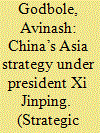

|
|
|
|
|
| Summary/Abstract |
China has reoriented its foreign policy strategy since Xi Jinping became president. This could significantly recast China’s relations with Asian countries. The process that began with Xi Jinping’s coming to power in 2012–2013 reached, in a sense, a definitive moment, with the Central Conference on Work Relating to Foreign Affairs held in Beijing in November 2014. From an earlier strategy of lying low to the present-day outlook of leading from the front and from a diplomatic strategy centred on great powers to one focusing on neighbourhood, China has come a long way within a relatively short space of time.
|
|
|
|
|
|
|
|
|
|
|
|
|
|
|
|
| 7 |
ID:
109744
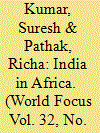

|
|
|
| 8 |
ID:
112650
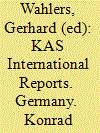

|
|
|
|
|
| Publication |
Germany, Konrad Adenauer Stiftung,
|
| Description |
107p.Pbk
|
| Series |
KAS International Reports 9/10/11
|
| Contents |
Volume 27
|
| Standard Number |
01777521
|
|
|
|
|
|
|
|
|
|
|
|
Copies: C:1/I:0,R:0,Q:0
Circulation
| Accession# | Call# | Current Location | Status | Policy | Location |
| 056438 | 304.8/WAH 056438 | Main | On Shelf | General | |
|
|
|
|
| 9 |
ID:
133288
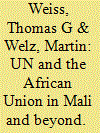

|
|
|
|
|
| Publication |
2014.
|
| Summary/Abstract |
The United Nations (UN) and the African Union (AU) have collaborated in building a viable African Peace and Security Architecture and have worked together in a number of armed conflicts over the past decade. Examples include the peace operations in Burundi and Somalia, and the hybrid peace operation in Sudan's Darfur region which is perhaps the most prominent illustration of this collaboration. Although the UN Security Council authorized the intervention in Libya, which was approved by leading regional organizations (the Arab League, the Organization of the Islamic Conference and the Gulf Cooperation Council), it was opposed initially by the AU although the three African states in the Security Council voted for it. Relations cooled as a result and have grown colder still as the UN snubbed the AU and its initial efforts to engage in post-conflict stabilization in Mali. While the AU sought to prove itself as a capable security provider and partner on the continent with its operation AFISMA, France's Opération Serval and the UN's peace operation for Mali, MINUSMA, bypassed the African Union. This article explores the underlying fault-lines between the two organizations by examining interactions between the UN and AU since the latter's launch in 2002, but focusing on the Mali case. The fault-lines emerging from the analysis are different capabilities, risk-averse vs risk-assuming approaches to casualties, diverging geopolitics and leadership rivalry.
|
|
|
|
|
|
|
|
|
|
|
|
|
|
|
|
| 10 |
ID:
142251
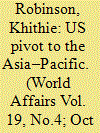

|
|
|
|
|
| Summary/Abstract |
According to Khithie Robinson, with the rise of Asian nations, American defence and foreign policies have undergone major changes and the US has been reshuffling the Asian balance of power by reshaping the security architecture in its own interest. India for its part should neither antagonise China, its largest neighbour and economic partner, nor move too close to the US. It thus needs to implement a carefully shaped foreign policy for dealing with the new international scenario.
|
|
|
|
|
|
|
|
|
|
|
|
|
|
|
|
| 11 |
ID:
143063
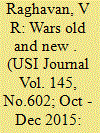

|
|
|
| 12 |
ID:
093784
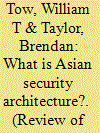

|
|
|
|
|
| Publication |
2010.
|
| Summary/Abstract |
Architecture' has emerged as the new catchphrase in Asian security politics. Despite its growing centrality, insufficient attention has thus far been given to defining the term, often leading to its imprecise usage. This article seeks to redress that shortcoming. It reviews the ways in which various scholars and practitioners have employed the term 'security architecture' and highlights the anomalies that their often differing employment has created. The article proposes a set of guidelines to aid conceptualisation and application of the term. In so doing it establishes criteria to ascertain what 'security architecture' actually exists in the Asian region, and must ultimately exist to assure regional security.
|
|
|
|
|
|
|
|
|
|
|
|
|
|
|
|
|
|
|
|
|